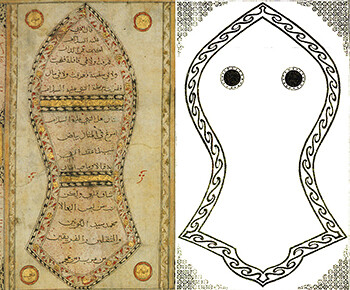Wednesday, April 5, 2017, 7pm
Reed College
Vollum lecture hall
Portland, Oregon
T 503 517 7851
[email protected]
Professor Flood’s lecture is organized by the Reed College Art Department in conjunction with the exhibition Iconoclastic, on view through April 28 at the Douglas F. Cooley Memorial Art Gallery. The Cooley will remain open until 6:45 pm prior to the lecture.
IconoclasticAbout the lecture
Although recent controversies about the historical representation of the Prophet Muhammad have focused on figural paintings, these were relatively rare and circulated in a limited milieu. More commonly, he was represented metonymically, by depictions of his footprint or sandal, for example. The most famous sandal relic was kept in Damascus, and from the 12th century onward images of this sandal relic were generated by tracing its outline. Tracings of tracings were often generated in their turn, disseminating the image of the sandal and its blessings from Morocco to India. This enchained series continued into modernity, when new print technologies and photography were applied to the reproduction of the sandal’s image. The deployment of modern technologies of mass (re)production is directly related to ongoing debates within Islam about the acceptability of relics, shrine veneration, and mediation. However, the perceived ability of mass-produced images to transmit the amuletic charisma of the original relic also raises larger questions about images, indexes, and the mediation of prophetic aura.
Finbarr Barry Flood is William R. Kenan Jr. Professor of the Humanities in the Institute of Fine Arts and College of Arts and Sciences at New York University. He earned a PhD from the University of Edinburgh in Islamic Art History and a BA from Trinity College in Archaeology with Mental and Moral Science. He specializes in art and architecture of the Islamic world and cross-cultural dimensions of Islamic material culture and is the author of numerous books, articles, and essays.
The Stephen E. Ostrow Distinguished Visitors Program in the Visual Arts was established by a generous 1988 gift from Edward and Sue Cooley and John and Betty Gray in support of art history and its place in the humanities. The lecture program enables Reed College’s art department to bring distinguished individuals in the arts to the college for periods of up to a week. These visitors give public lectures and engage in seminars with students. The intent of the program is to bring to campus creative people who are distinguished in connection with the visual arts and who will provide “a forum for conceptual exploration, challenge, and discovery.” The program is named in honor of art historian Dr. Stephen E. Ostrow as a tribute to his career and out of respect for his advisory role in the formulation of the Cooley-Gray gift and the design of the Douglas F. Cooley Memorial Art Gallery. Ostrow is the Chief Curator Emeritus of the Prints and Photographs Division of the Library of Congress, Washington D.C.
The Douglas F. Cooley Memorial Art Gallery, Reed College, is an intimate academic museum, nestled in the Reed College library. The Cooley was established by a generous 1988 endowment from Sue and Edward Cooley and John and Betty Gray “in support of the teaching of art history at Reed College, as part of an interdisciplinary educational experience that strengthens the art history component of Reed’s distinctive humanities program.” Exhibitions are curated by director Stephanie Snyder, often in collaboration with Reed faculty and courses across the disciplines, with attention to the needs and interests of the larger Portland and Northwest arts communities. A schedule of three to four exhibitions during the academic year brings to Reed and the Portland community work that would not otherwise be seen in the region.
Douglas F. Cooley Memorial Art Gallery, Reed College
3203 SE Woodstock Blvd.
Portland, Oregon 97202




